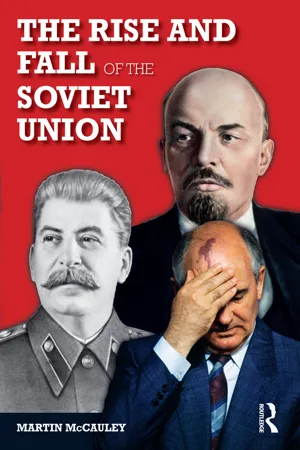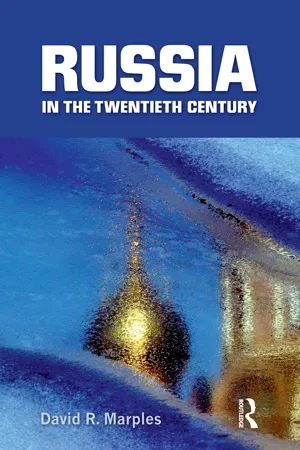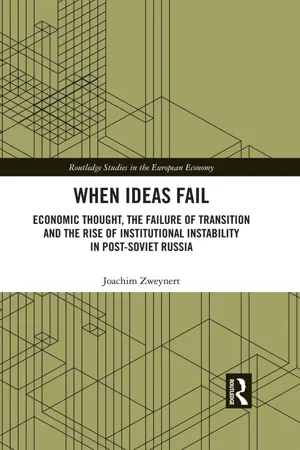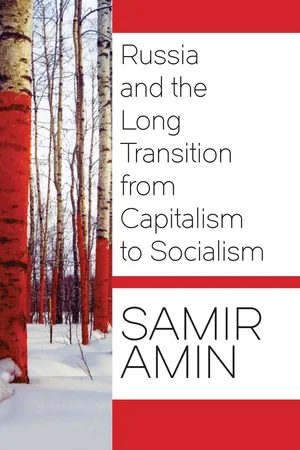History
Brezhnev Era
The Brezhnev Era refers to the period of Soviet history from 1964 to 1982, during which Leonid Brezhnev served as the General Secretary of the Communist Party of the Soviet Union. This era was characterized by a period of political stability, economic stagnation, and the continuation of the Cold War. It also saw the development of détente, a period of improved relations between the Soviet Union and the United States.
Written by Perlego with AI-assistance
Related key terms
7 Key excerpts on "Brezhnev Era"
- eBook - ePub
- Martin Mccauley(Author)
- 2014(Publication Date)
- Routledge(Publisher)
Chapter 20 The Brezhnev Era Leonid (Lenya) was universally perceived as a dimwit. However unfair this may have been, it gave rise to a multitude of jokes at his expense. Nevertheless, everyone was expected to extol his virtues and to acknowledge him as a wise leader. ‘Have you heard that Brezhnev is going to have surgery? He’s having his chest widened to accommodate more medals.’ The Brezhnev Era breaks down into three phases: 1 1964–68: Leonid Brezhnev emerges as the dominant Soviet leader, pushing Aleksei Kosygin aside. Attempts are made to make industry and agriculture more dynamic. Socialism with a human face in Czechoslovakia, in the spring of 1968, is the first great challenge. The Warsaw Pact invasion, in August 1968, ends an alternative, more popular brand of Marxist socialism. It also kills off reform in the Soviet Union. The deeply ingrained Russian belief in centralisation reasserts itself. The Brezhnev doctrine means that it is the comrade in the Kremlin who decides if socialism was under threat in the world-wide socialist commonwealth. Naturally the Chinese reject this. Moscow is claiming greater responsibility for the socialist world at a time of declining economic growth. 2 1969–75: The Soviet Union looks inwards and becomes culturally conservative. No real attempt is made to address the economic problems facing the country. The Party and governmental apparatuses consolidate their power. The KGB, under Andropov, becomes a force in the land as opposition from the intelligentsia and ordinary people mounts. The belief grows that the national liberation movements in the Third World are paving the way for the defeat of American imperialism. Mao provokes a war scare by killing Soviet border guards in March 1969; Russians kill many Chinese and also penetrate Xinjiang. Strategic Arms Limitation Treaty (SALT I) signed in 1972. Brezhnev signs the Helsinki Final Act, in 1975. It confirms the post-war boundaries in Europe - Alastair Kocho-Williams(Author)
- 2013(Publication Date)
- Routledge(Publisher)
9 The Brezhnev Era With Khrushchev’s departure from office in October 1964, the Soviet Union once again entered into collective leadership under Leonid Brezhnev as General Secretary of the Communist Party of the Soviet Union and Alexei Kosygin as the Premier. In contrast to Khrushchev’s rash gambling, the pair seemed to be much more cautious and, indeed, to embody a more technocratic approach of making the system work. In many ways, the Brezhnev and Kosygin partnership was much more introspective in its early years, not least in reaction to the disasters into which Khrushchev had led the Soviets on the international stage. Brezhnev gradually became the dominant partner and de facto leader of the Soviet Union. As time went on, Brezhnev found that there was still much to be dealt with in terms of foreign policy and in competition with the West. His time in office was marked by an initial reversal of many of Khrushchev’s policy positions and a return to policies that harked back to the Stalin era. Restalinization became a reality under Brezhnev, with repression and control within the Soviet Union and its Eastern European satellites. The economy improved before 1973, but then began to decline and stagnate, not least as a result of heavy expenditure on defence and armaments. Brezhnev’s foreign policy was marked by an initially difficult relationship with China, the United States and the Eastern bloc. While repression was used to deal with an early challenge in 1968 from Czechoslovakia, Brezhnev was able to achieve rapprochement with China and a period of more cordial relations with the United States, known as détente. In the first decade of Brezhnev’s rule his foreign policy appeared to be successful, not least as it was set against the United States’ entrenchment in the quagmire of the Vietnam War. During the 1970s the relationships with the United States and with China seemed to be largely repaired and arms limitation talks began in earnest- eBook - ePub
Russia in the Twentieth Century
The quest for stability
- David R. Marples(Author)
- 2014(Publication Date)
- Routledge(Publisher)
By the late 1960s and early 1970s, the indigenous populations in most of the non-Russian republics could be found in positions of authority. In the Baltic republics, particularly Lithuania, Russians had been virtually excluded from the power structure. In Central Asia, the progress had been slower, but already the native populations comprised more than half of the ruling party elite. Was this phenomenon a sign of the success of the Soviet regime or of its failure? The ageing masters of the Kremlin decided the latter. In Belarus, Russians dominated the party leadership; but, in Minsk, Petr Masherov had distanced himself from the corruption and intrigue of the Kremlin. He had remained a more steadfast Communist and moreover one significantly more popular than Brezhnev himself. Masherov’s role was important in keeping alive a Belarusian entity. Belarusians in this period generally had a good standard of living and were free from the political intrigues and high-level official farce in Moscow. At the same time, the Russian language had assumed a position of control over state and urban life. The vast majority of books, journals, and newspapers were published in Russian. Because of the similarity of the Belarusian and Russian languages, and the “invisibility” of the large Russian minority, an acute level of Russian linguistic assimilation took place in the republic, making it much more difficult for subsequent national self-assertion. In Moldavia, the leadership was under firm Russian and Slavic control. One may exaggerate the dilemma that arose before the Politburo by the mid-1970s – the ruling elite itself was Russian (including ten out of twelve members of the Politburo elected in this decade). As the Politburo grew in size, Russian membership was maintained. The authorities also tried to stress the natural friendship and links between the three Slavic nations, their common roots in the Kyivan state of the 10th century, and a common history in which the key aspect was Russian friendship and guidance of the “younger brothers.” Often state propaganda would revert to the war years, to a theme of common actions against a foreign occupant, heroism, and love for the Motherland. In turn, the growing Soviet power in the world was also a common topic. The period had hardly been a successful one for the rival power, the United States, which had suffered badly – particularly in terms of internal protests – during the war in Vietnam. The Brezhnev regime therefore sought to present an image of a state that was united and based on the friendship of its peoples. National distinctions thus were blurred as far as possible. Yet they were never eradicated and would re-emerge during the Gorbachev period as a new and pressing dilemma for the Soviet leadership.Foreign policy under Brezhnev
Introduction
Under Brezhnev, the foreign policy pursued several aims. In Eastern Europe, it faced threats of Communist Party reform and, toward the end of Brezhnev’s leadership, the creation of an independent trade union in Poland. In the developing world, the Soviet Union took advantage of decolonization to spread its influence in India and Afghanistan; in several African countries it established a foothold either directly or by proxy. Relations with China were hostile, and resulted in several military clashes on both sides of the border. At this time China became the main enemy of the Soviet Union. Finally, in the Cold War conflict with the United States, the Soviet leadership was able to reach a position of approximate parity, to promote détente and an official peace campaign. The culmination point was the signing of a SALT-2 Treaty with the United States in Vienna, though the latter did not ratify this, preferring first to ensure that the missile situation in Europe was made more even. By the mid-1970s, the signing of the Helsinki agreement brought a practical end to the Second World War, recognizing the current boundaries, the two German states, and the agreement of the Soviet Union to respect human rights. The period 1964–1982 can be regarded as one of Soviet consolidation and military growth. It saw two Soviet invasions of neighbors – one within Europe and one in the Near East. These were to be justified by the so-called Brezhnev Doctrine, but they revealed that the Communist giant was in essence an imperial regime that would use force to expand its power or to ensure that its satellite states did not try to break the links with Moscow. - eBook - ePub
When Ideas Fail
Economic Thought, the Failure of Transition and the Rise of Institutional Instability in Post-Soviet Russia
- Joachim Zweynert(Author)
- 2017(Publication Date)
- Routledge(Publisher)
3The legacy of the Brezhnev period: 1971–1986Why deal with the Brezhnev period?
The Brezhnev years are highly relevant for two reasons for what happened later. First, the reform concepts of the people of the sixties (shestidesiatniki ), which have their roots in this period, provided the background to Gorbachev’s reforms and later to the opposition of a then older generation of economists against Western mainstream economics. In other words, the ideas of one of the two thought collectives in today’s Russian economic science can be directly traced back to this period. Secondly, in order to comprehend the thesis that – not only in ideational terms – the country today is approaching a kind of “neo-zastoi ” (standstill), it is important to be familiar with the ideational foundations of the Soviet order of the 1960s to early 1980s. Both the political ideology of the Brezhnev period, in the centre of which stood the notion of “developed socialism” (see e.g. Evans 1977; Kelley 1977; Sandle 2002) and the development of Soviet economic thought in the 1960s to 1980s are relatively well researched topics (Sutela 1991, 2008; Sutela and Mau 1998), but to my knowledge no systematic research has yet been done into the relationships between economic ideas and the political doctrine behind what has later been labelled the period of zastoi .1It is important to note that the idea of developed socialism and its economic counterpart, the concept of “perfectioning of the economic mechanism”, were by no means inventions of the Soviet politburo. Both had their origin in the context of reformist thinking in Central Eastern Europe, from where they were imported into the Soviet Union. The Soviet versions of the two above-mentioned concepts, as introduced into the official discourse by Leonid Brezhnev in his speech at the 24th Communist Party Congress in 1971, took up key reformist topics (and thus seemingly made concessions to the critics of over-centralisation), yet at the same time decisively tightened the borders within which these topics could be discussed. - eBook - ePub
Politics and Justice in Russia: Major Trials of the Post-Stalin Era
Major Trials of the Post-Stalin Era
- Yuri Feofanov, Donald D. Barry(Authors)
- 2019(Publication Date)
- Routledge(Publisher)
3 But as a conservative he felt more comfortable with the highly controlled system that Stalin had created, and so sought to re-establish it, without the bloody repressions.Under Brezhnev and the conservative cohort that he gathered around him, the country entered a period of relatively few experiments and of little innovation. Reform, such as it was, amounted to no more than tinkering at the margins. It gradually became clear that the country was not keeping up in the scientific-technical revolution that was taking place in the rest of the world. This must have been enormously frustrating for some of his fellow party leaders such as Andropov, and for some of the younger generation such as Gorbachev and Shevardnadze, not to mention scientists and scholars, who had some sense of what the rudderless leadership of the late 1970s and early 1980s was doing to the country. But the political system had so congealed that removing an ineffective but personally unobjectionable leader had become all but impossible. The country could only wait.It was this later part of Brezhnev’s rule that came to be known as the period of stagnation (zastoi). If not inevitable, stagnation was certainly one of the likely results of the conservatism of the early Brezhnev period. From the start, prime importance was accorded by Brezhnev and his conservative lieutenants to a high level of control over political operations. The prime objective was to maintain the system against all challenges to its authority.Such challenges, no matter how remote or secondary in importance, were met with strong responses from the party-state machine. The “Prague Spring” in 1968 seemed to threaten the Soviet empire in Eastern Europe, so it was snuffed out by Soviet military force. The state agricultural system was performing poorly, but any innovations that involved substantial incentives to individual farmers were squelched. The few analogous experiments in industry met the same end. Religion was neutralized, to the extent possible, by co-opting the Russian Orthodox Church in exchange for favors to it from the regime, while a negative policy toward other religions was pursued. All manner of restrictions on intellectual life were maintained, from more subtle incentives/pressures, such as allowing or withholding the privilege of traveling abroad, to blatant and brutal repressions, such as bulldozing a modem art show in Moscow in 1974, where foreign newsmen and others were beaten by police goons.4 - Samir Amin(Author)
- 2016(Publication Date)
- Monthly Review Press(Publisher)
The analyses, judgments, and even forecasts must be put into a context, although they were always more or less affected by the circumstances of the changes under consideration. During these thirty years, the Soviet system has evolved, sought to respond to the crisis, and gone through various phases.The period following Stalin’s death in 1953, and especially from the Twentieth Congress in 1956 to the fall of Khrushchev in 1964, was marked by a first attempt to recover from Stalinism and by the open ideological and political dispute between Moscow and Beijing. The next period of so-called Brezhnev glaciation (immobilist strategy) lasted until the arrival of Gorbachev in 1985. Gorbachev’s attempt at perestroika after 1985 ended within a few years in the collapse from 1989 to 1991.China was at the same time also seeking alternative responses to the problem of building socialism in its own terminology. There was the Maoist attempt from 1961 to 1976, culminating in the Cultural Revolution from 1966 and the gradual slide which led to Deng Xiaoping’s economic and political strategy that was characteristic of the 1980s.The evolutions and successive phases had to be articulated on those operating at a world level. This meant capitalist expansion and the building of the European Economic Community (EEC) and competition between the United States, Japan, and Europe. It meant military balances between the two superpowers and political responses in the arms race. In the Brezhnev period, it meant Soviet initiatives toward the Third World and conflict with China on the one hand, and U.S. Cold War strategies, including Star Wars preparations after 1980, on the other. Internal options and international policies were intertwined during these thirty years.Of course, the Soviet system does not date from 1960, and our reflections are based on our analysis of both the 1917 Russian Revolution and the Chinese Revolution, Leninism, Maoism, and Stalinism. It is not our intention to propose a new reading of the seventy-five years of Soviet history. The forty-year period from 1917 to 1957, when successive phases of the evolution of the Soviet system were linked to various moments of world history, will not be examined here, nor will postwar Stalinism and the early Cold War.- eBook - ePub
Russia
A Historical Introduction from Kievan Rus' to the Present
- Christopher J. Ward, John M. Thompson(Authors)
- 2021(Publication Date)
- Routledge(Publisher)
Undercut by the Soviet invasion of Afghanistan, détente suffered another blow in 1980 with the accession to office of a new American president, Ronald Reagan, who was committed to an expansive military buildup and global opposition to what he later called the Soviet “evil empire.” Moreover, the crushing in 1981 of an independent Polish workers’ movement, Solidarity, further strained Soviet–Western relations. Solidarity, which numbered ten million members, arose spontaneously in the summer of 1980 to protest economic inequities and government mismanagement and corruption in Poland. But when Solidarity pressed for political control and threatened one-party socialist rule, General Wojciech Jaruzelski, under pressure from Moscow, declared martial law in December 1981 and banned the movement. Western leaders protested vigorously but could do nothing.Détente collapsed in part because each side conceived the process differently. US leaders and the public believed that it meant not only a relaxation of tensions but positive and trusting cooperation. For their part, Brezhnev and his colleagues never assumed that détente signified a cessation of superpower competition in the world arena. They wanted to reduce tensions where possible and to strike deals of mutual self-interest but not to abandon their revolutionary prerogative of stirring up trouble for the imperialists wherever they could.By the time of his death in 1982, Brezhnev’s foreign policy lay in shambles. He had achieved nuclear parity with the United States and used military strength to expand Soviet influence in the Third World, but the collapse of détente and the war in Afghanistan placed heavy burdens on the Soviet Union. His successors faced an accelerating arms race, a continuing dispute with China, and expensive commitments abroad.Soviet Society in Flux
Brezhnev’s emphasis on political stability masked deep-seated changes in Soviet society from the 1960s to the early 1980s. Soviet citizens became increasingly urbanized and more highly educated in that period. Two out of three people now lived in cities, ending the dominance of rural culture and outlooks in Russian and Soviet life. In 1981, more than 10 percent of the Soviet population had completed higher education, compared to 1.5 percent in 1959; more than 70 percent had completed secondary school, against 12 percent in 1959. Most people were also more knowledgeable about the outside world and more skeptical about the regime’s claims and record.A generation gap had developed as well. By 1980, those under the age of fifty had only the dimmest memory of World War II, and those under forty-five had no adult experience with Stalinism. An aging leadership shaped by the Stalin era thus ruled a predominantly post-Stalin population. Younger people were increasingly critical of the deceptions, inefficiencies, restrictions, and failed promises of Soviet socialism. They came to believe that the system could do better, that basic changes were needed.
Learn about this page
Index pages curate the most relevant extracts from our library of academic textbooks. They’ve been created using an in-house natural language model (NLM), each adding context and meaning to key research topics.






